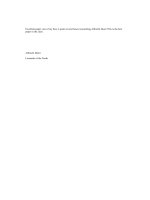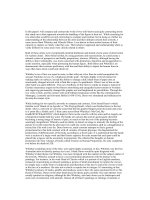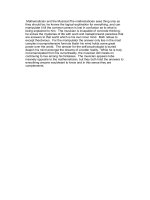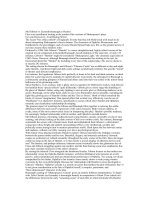albrecht durer vs brett whiteley 1238
Bạn đang xem bản rút gọn của tài liệu. Xem và tải ngay bản đầy đủ của tài liệu tại đây (41.7 KB, 2 trang )
In this paper I will compare and contrast the work of two well-known and quite contrasting artists
that stand out in their approach towards the handling of the figure in their art. While searching for
two artists that would be not only interesting to compare and contrast, but in doing so, further my
understanding of the relationship between the artist and their attitude towards their artwork, I
came across Brett Whiteley and Albrecht Dürer. I was drawn to these artists because of their
capacity to capture so clearly what they saw. Their talents in approach and craftsmanship while so
vastly different in some areas were closely related in others.
Both of these artists were exceptionally talented draftsmen and shared a keen sense of observation
for realistic detail. Dürer believed that, by using geometry and measurement, he could create a
rational system of perspective and bodily proportions, whereas, Whiteley, although having the
ability to draw realistically, was more concerned with abstraction, distortion and exaggeration to
create emotion, especially when portraying the human figure. Both Dürer and Whiteley's art
demonstrates their extreme proficiency with line and their ability to depict the human form in
ways that many artists could only dream of.
Whiteley's use of line was equal to none, in that with just a few lines he could encapsulate the
sensual, feminine curves of a voluptuous female nude. He had a highly evolved instinct for
making marks on surfaces, he had the ability to change a dull, blank sheet of paper into an
emotionally charged artwork with a fluid like swipe of a paintbrush. Dürer's use of line on the
other hand was quite different. The use of millions of fine lines to render an image is typical of
German renaissance engravers but Durers astonishing and unequalled achievements in woodcut
and engraving permanently changed the graphic arts and heightened its possibilities. Through his
two visits to Italy, and his contact with such brilliant renaissance artists like his contemporaries
Mantegna, Leonardo and Giovanni Bellini (1430-1516), Durer was stimulated and influenced to
develop his unique style.
While looking for two specific artworks to compare and contrast, I first found Durer's widely
familiar work 'Hands of an Apostle' or 'The Praying Hands', which was finished down to the last
detail. Above a network of veins the somewhat thin but gnarled fingers point skywards and come
to a 'point like a Gothic arch'. I then came across Brett Whiteley's 'My God, My
God…Why…' which depicts Christ on the crucifix with his arms and his largely out
of proportion hands held sky ward. The hands are cartoon-like and are grotesquely distorted
becoming a strong image of intense of pain, so much so that the rest of the painting becomes
seemingly insignificant. Whiteley used his ability to distort an image to intensify the feeling of the
picture to its full extent but he also knew he could rely on his tremendous skill as a draughtsman to
rescue him if he took it too far. Durer however, made constant attempts to find a general
proportional law that held constant with all varieties of human physique. He diagrammed the
proportions of different parts of the body according to a fixed scale. It is understood that the hands
were a section of a larger work and that Durers capacity for scale meant that each part could be
placed like a jigsaw and be accurately in proportion. He collected his thoughts on human
proportion into four volumes of books called Treatise on Human Proportions. He only completed
two before his death in1528.
Whiteley's paintings most of the time, were quite highly sexualised, in fact, Whiteley was the first
Australian artist to directly portray sex in art. I think Durer would be quite disgusted with
Whiteley's blunt theme, but Whiteley was more intrigued with the manner not the subject matter of
the artwork. Whiteley seemed to have a cool sentimental detachment with the themes in his
paintings. For instance, in his work Head of Christie which is a portrait of an English murderer,
instead of concentrating on directly painting a picture of death and despair to repulse the viewer,
he simply uses a subtle form of composition and distortion of the face to entice the viewer to look
at the face of a murderer. He aims not to shock or repulse but to intrigue. It's interesting in that
Whiteley's pictures of nudes, giraffes and monkeys seem to have the same emotional level as The
Head of Christie. Durer on the other hand chose his theme quite carefully. His main themes were
usually spiritual or religious, although he like Whiteley, also had a keen eye for landscapes and
some sort of connection with animals. Almost all of Durer's paintings or etchings of animals or
landscapes were so detailed that they could perhaps be accurate enough for a botanist or biologist
to use today. I think, Durer's connection with animals sometimes led him to mix his themes, as in
his Virgin with a Multitude of Animals, 1503, where he surrounds the Virgin with a gathering of
gentle animals including a parrot, a fox, a poodle, some owls and a crab.
One of Durer's favourite themes however, was himself. His self-portraits were all precisely
finished and all portrayed him as a handsome young man. He completed four self-portraits during
his life the first of which when he was only thirteen. It is an amazingly accomplished self-portrait
and was not only his earliest known work but is also the first recognised self-portrait in German
art. The last self-portrait he painted was at the age of 29 in 1500, where he deliberately portrayed
himself in the style of a painting of Christ. He idealised his own features to resemble that of
Christ, not to show himself as the reincarnation of Jesus, which to a good Christian would be
blasphemous, but he believed that his gift of art was god given. Although Durer often painted
self-portraits he hardly ever painted his wife, and when he did they weren't that flattering.
Whiteley nevertheless, used his girlfriend as a constant theme in his art. He painted her not to
show her in a sense but to show the female form.
Two widely different personalities in two vastly different eras, the fifteenth Century and the
twentieth Century have shown me how the quality of draughtsmanship and line can have such a
strong impact on the viewer of the figure. Whilst Durer struggled in the changing time of the
German Gothic era to the beginning of the wonderfully flamboyant Italian Renaissance, Whitely
was also an artist of a changing era. His paintings especially the abstracted figure encapsulated the
sexual revolution of the sixties and enriched the Australian art tradition. They both were drawn to
the human and animal form and while Durer embraced realism in the time where developing
science was the changing the way the world saw itself, Whiteley was seeking the abstract when
science was being questioned, and the search for more inner truths was a sign of the times. Their
construction of the figure displays all these concepts.
Bibliography:
GAUNT, William, "Everyman's Dictionary of Pictorial Art",Vol 1. 1962. K.M Dent and Sons.
London
GLEESON James (ed) 'Masterpieces of Australian Painting',1969. Landsdowne Press Melbourne
HORTON, M. "Australian Painters of the '70's", 1975 Ure Smith Press, Sydney
HUGHES, Robert, "The Art of Australia" 1966 Penguin Aus.
RUSSELL Francis, "The World Of Durer c. 1471-1528" 1967 Time Life Inc. NY.









